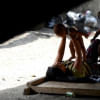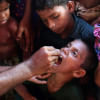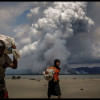Rohingya census begins in 6 dists
The government yesterday began a household survey to register the undocumented Rohingya population and also to get an idea of the circumstances under which they fled their home country, Myanmar.
A census will follow the survey to determine the number of Rohingyas living in Bangladesh and their socioeconomic conditions, said Alamgir Hossain, the project director.
This would be the first ever census on the unregistered Rohingya population, an ethnic Muslim minority in Buddhist-majority Myanmar that does not recognise them as its citizens. International rights bodies see the Rohingya population as one of the most persecuted groups in history.
Last year, Myanmar did its first survey in 30 years, excluding the Rohingya population.
Currently, only 33,000 Rohingyas are registered in the two official refugee camps in Cox's Bazar. But the Planning Commission in its project proposal for the survey put the number of unregistered Rohingyas living in the region between three and five lakh.
On average, eight to ten Rohingyas enter Bangladesh from the neighboring country through porous border every day, the proposal paper says.
The survey will be done simultaneously in six districts -- Chittagong, Cox's Bazar, Rangamati, Khagrachhari, Bandarban and Patuakhali -- where most Rohingya refugees are believed to be concentrated.
The survey is expected to be completed on February 17, said Emdadul Huq, joint director (Chittagong division) of the Bangladesh Bureau of Statistics, which is doing the survey.
Then in late March, a census will begin based on the survey data. Following the census, the government plans to create a database of the Rohingyas along with their photos and addresses where they lived in Myanmar.
The International Organisation for Migration (IOM) is providing assistance in doing the survey and creating awareness among the Rohingya population to take part in it, the BBC Bangla reports.
Households under the survey will be listed in three categories -- M (Myanmar National), B (Bangladeshi), and X (in case of a Bangladeshi and a Rohingya are living together under any social bonds like marriage), said Emdadul.
With physical features very similar to those of Bangalees, Rohingyas can mix well with the Bangladeshi community. Unless they disclose their identities, it is hard to distinguish them from Bangalees. This is the reason why Bangladeshi households in the coastal region are also included in the survey, to see if any Rohingyas live in those houses temporarily or permanently.
Information of the Rohingyas living outside the areas will be collected through family members, relatives and friends, Emdadul added.
The six districts have been divided into 243 zones. As many as 6,974 enumerators will collect information going door to door under 811 supervisors, said Mizanur Rahman, Barisal division's joint director of the BBS.
The Tk 21.55-crore project was approved in April last year, but it faced delay for various reasons, said Alamgir, the project director.
Holding of such a survey has been in the discussion for a while, but got momentum only after it emerged that overseas human trafficking through the Bay of Bengal boomed, riding on the Rohingya refugees.
International newspapers estimate there are 1.1 million Rohingyas in Myanmar's Rakhine state. Since 2012, about 140,000 Rohingyas have fled the country, mainly due to sectarian violence.
Entering into Bangladesh, some members of the community engage in criminal and even militant activities, according to media and police reports.
The intrusion of Rohingyas has become a common feature in the region since their first influx as refugees in 1978. The problem of illegal migration turned acute after the second influx in 1991-92.
(Our correspondents from Cox's Bazar and Chittagong contributed to this report.)

 For all latest news, follow The Daily Star's Google News channel.
For all latest news, follow The Daily Star's Google News channel. 








Comments